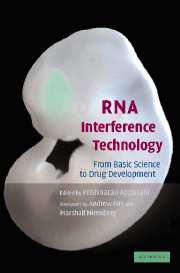Book contents
- Frontmatter
- Contents
- Foreword by Andrew Fire
- Foreword by Marshall Nirenberg
- List of Contributors
- Introduction
- Section one Basic RNAi, siRNA, microRNAs and gene-silencing mechanisms
- Section two Design, synthesis of siRNAs
- Section three Vector development and in vivo, in vitro and in ovo delivery methods
- Section four Gene silencing in model organisms
- Section five Drug target validation
- Section six Therapeutic and drug development
- 26 RNAi-mediated silencing of viral gene expression and replication
- 27 RNAi in drug development: Practical considerations
- 28 RNA interference studies in liver failure
- 29 RNAi applications in living animal systems
- Section seven High-throughput genome-wide RNAi analysis
- Index
- Plate section
- References
26 - RNAi-mediated silencing of viral gene expression and replication
Published online by Cambridge University Press: 31 July 2009
- Frontmatter
- Contents
- Foreword by Andrew Fire
- Foreword by Marshall Nirenberg
- List of Contributors
- Introduction
- Section one Basic RNAi, siRNA, microRNAs and gene-silencing mechanisms
- Section two Design, synthesis of siRNAs
- Section three Vector development and in vivo, in vitro and in ovo delivery methods
- Section four Gene silencing in model organisms
- Section five Drug target validation
- Section six Therapeutic and drug development
- 26 RNAi-mediated silencing of viral gene expression and replication
- 27 RNAi in drug development: Practical considerations
- 28 RNA interference studies in liver failure
- 29 RNAi applications in living animal systems
- Section seven High-throughput genome-wide RNAi analysis
- Index
- Plate section
- References
Summary
Introduction
RNA interference (RNAi) is a gene-silencing technique first described by Fire and colleagues in Caenorhabditis elegans (Fire et al., 1998). They found that the introduction of long dsRNA into the nematode C. elegans led to the targeted disruption of the homologous mRNA. RNAi is related to a variety of other gene-silencing phenomena including posttranscriptional gene silencing (PTGS) in plants and quelling in the fungus Neurospora crassa (Jorgensen, 1990; Romano and Macino, 1992). The link between these seemingly divergent processes is the presence of dsRNA homologous to the silenced gene (Bernstein et al., 2001b; Waterhouse et al., 2001).
The addition of long dsRNAs into Drosophila melanogaster embryo extracts was shown to silence gene expression in a sequence-specific manner, recapturing the RNAi reaction in vitro (Tuschl et al., 1999). Although initiated by long dsRNA, the effector molecules that guide the mRNA degradation were found to be small (21- to 23-nt) dsRNA species, termed small interfering (si)RNAs, produced by the cleavage of the long dsRNAs (Zamore et al., 2000). The introduction of chemically synthesized siRNAs into the extracts was found to be sufficient for targeting mRNA degradation (Elbashir et al., 2001a). Similarly, small RNA species were found in vivo in a wide variety of organisms and cells undergoing dsRNA-mediated gene silencing including plants, Drosophila embryos, Drosophila Schneider 2 (S2) cells and C. elegans (Hamilton and Baulcombe, 1999; Hammond et al., 2000; Parrish et al., 2000, Yang et al., 2001).
Information
- Type
- Chapter
- Information
- RNA Interference TechnologyFrom Basic Science to Drug Development, pp. 363 - 383Publisher: Cambridge University PressPrint publication year: 2005
